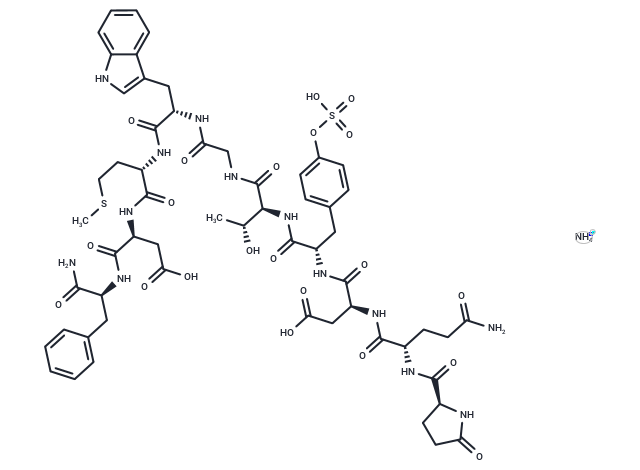Shopping Cart
Remove All Your shopping cart is currently empty
Your shopping cart is currently empty
Ceruletide Ammonium Salt is a decapeptide, originating from the skin of tropical frogs, which is a potent cholecystokinin receptor agonist and a safe and effective cholecystokinin receptor agonist with direct spasmodic effects on the gallbladder muscle and bile ducts. Ceruletide Ammonium Salt has sedative activity and has been used in the study of chronic schizophrenia.Ceruletide Ammonium Salt is a decapeptide, originating from the skin of tropical frogs.

| Pack Size | Price | USA Warehouse | Global Warehouse | Quantity |
|---|---|---|---|---|
| 1 mg | $89 | - | In Stock | |
| 5 mg | $347 | - | In Stock | |
| 10 mg | $516 | - | In Stock | |
| 25 mg | $825 | - | In Stock | |
| 50 mg | $1,090 | - | In Stock | |
| 100 mg | $1,480 | - | In Stock | |
| 500 mg | $2,930 | - | In Stock | |
| 1 mL x 10 mM (in DMSO) | $30 | - | In Stock |
| Description | Ceruletide Ammonium Salt is a decapeptide, originating from the skin of tropical frogs, which is a potent cholecystokinin receptor agonist and a safe and effective cholecystokinin receptor agonist with direct spasmodic effects on the gallbladder muscle and bile ducts. Ceruletide Ammonium Salt has sedative activity and has been used in the study of chronic schizophrenia.Ceruletide Ammonium Salt is a decapeptide, originating from the skin of tropical frogs. |
| In vitro | Ceruletide Ammonium Salt shares chemical and biological similarities with the gastrointestinal hormones cholecystokinin (CCK) and gastrin II in humans. Ceruletide Ammonium Salt stimulates gallbladder contraction, pancreatic exocrine secretion, gastric fluid secretion, and motility in the distal duodenum, jejunum, ileum, and colon, while delaying gastric emptying and inhibiting motility in the proximal duodenum[2]. In vitro, Ceruletide Ammonium Salt activates NF-kappaB/Rel at supraphysiological doses rather than at physiological levels. This activation may induce a self-protective genetic program before cell damage occurs, potentially preventing a higher degree of injury to pancreatic acinar cells after excessive stimulation by secretagogues[1]. |
| In vivo | Ceruletide Ammonium Salt can be utilized for animal modeling, specifically in constructing animal models of pancreatitis. Ceruletide Ammonium Salt (0.4-0.5 μg/kg, intravenous injection; 3-4 μg/kg, subcutaneous injection) induces conscious and complete vomiting and defecation in dogs, with full recovery observed 15-30 minutes and 2-4 hours after intravenous administration or subcutaneous injection, respectively. Ceruletide Ammonium Salt (5-15 ng/kg, intravenous) demonstrates a significant spasmogenic effect on the pylorus in rats. Additionally, Ceruletide Ammonium Salt can reduce blood pressure in anesthetized dogs[2]. Ceruletide Ammonium Salt-stimulated serum bile acids (SBA) evasion eliminates exogenous and endogenous influences associated with postprandial (PP) SBA stimulation. The effectiveness of Ceruletide Ammonium Salt-stimulated SBA in dogs with portosystemic shunts (PSS) may be as good as PP SBA stimulation, and it may be more sensitive in detecting hepatic dysfunction in dogs with upper respiratory disease (URD)[3]. |
| Synonyms | FI-6934 Ammonium Salt, Ceruletide Ammonium Salt(17650-98-5 Free base), Cerulein Ammonium Salt, Caerulein Ammonium Salt |
| Molecular Weight | 1370.44 |
| Formula | C58H77N14O21S2 |
| Smiles | NC([C@H](CC1=CC=CC=C1)NC([C@H](CC(O)=O)NC([C@H](CCSC)NC([C@@H](NC(CNC([C@H]([C@H](O)C)NC([C@@H](NC([C@H](CC(O)=O)NC([C@H](CCC(N)=O)NC([C@H]2NC(CC2)=O)=O)=O)=O)CC3=CC=C(C=C3)OS(=O)(O)=O)=O)=O)=O)CC4=CNC5=CC=CC=C45)=O)=O)=O)=O.[NH4+] |
| Relative Density. | no data available |
| Sequence | {pGlu}-Gln-Asp-Tyr(SO3H)-Thr-Gly-Trp-Met-Asp-Phe-NH2 |
| Sequence Short | {pGlu}-QD-Y(SO3H)-TGWMDF-NH2 |
| Storage | store at low temperature,keep away from moisture | Powder: -20°C for 3 years | In solvent: -80°C for 1 year | Shipping with blue ice/Shipping at ambient temperature. |
| Solubility Information | H2O: < 1 mg/mL (insoluble or slightly soluble) |
| Size | Quantity | Unit Price | Amount | Operation |
|---|

Copyright © 2015-2026 TargetMol Chemicals Inc. All Rights Reserved.